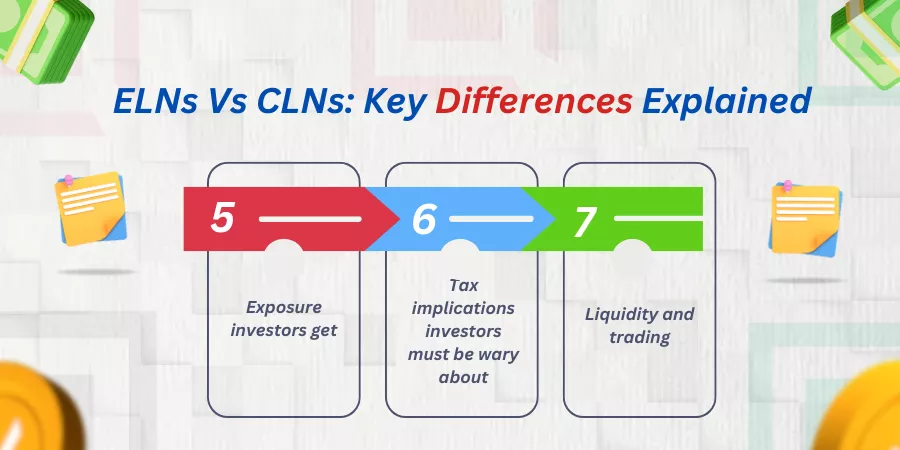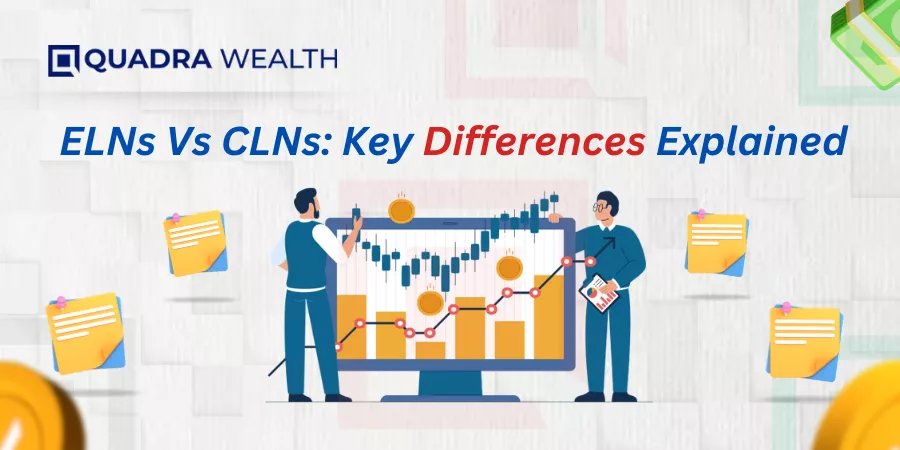Introduction
ELNs and CLNs are both structured products. You find that these are structured notes you may have to deal with.
While ELN stands for Equity-Linked Note, CLN stands for Commodity-linked note. ELN is a type of structured note wherein you have the note underlying with equity based derivatives.
The note can comprise of equity products like shares, a basket of high-paying stocks or securities to name a few. The bond portion of the note protects investor’s capital if you pick a principal protected ELN. The rate of returns of the note potentially depend on how well the assets perform throughout the tenor of the note.
If the underlying assets consistently perform well in the market, you can get a potentially higher returns over traditional bonds or fixed-income securities.
On the contrary, if the underlying performance of ELN does not do well, then investors can see a drop in the value of their capital wallet.
Now, let us understand what a CLN is all about. CLN stands for Commodity-linked note. Here, the note underlies commodities like gold, silver, oil, natural gas, wheat or coffee. The market identifies commodity-indices and look at how these products perform across the market. The value of the investment portfolio soars or drops according to commodity-based indices. The returns of the CLN is also calculated accordingly.
If your underlying commodities show a significant rise in value, you get returns plus capital in lieu of the same. On the contrary, if the value of your indexed commodities drop in their price values, the value of your CLN drops too.
Now, do you want to learn more interesting differences covering ELNs Vs CLNs? Well then, we have completely got you covered here:

Looking at the asset allocation of each underlying note
For an ELN, the note comprises of underlying assets like equity shares, stocks and high paying market securities. The performance indexes are based on equity indices and the value of the investment portfolio can increase or decrease based on the performance of the asset portfolio.
Whereas, for a CLN, the asset allocation comprises of commodities like gold, silver, copper, oil and natural gas, wheat, coffee or dairy products to name a few. The market for this investment tenor is fluctuating prices of commodity-based indices. The value of investment can increase or decrease with changes in commodity indices for a CLN.
Market behaviour
The performance of equities is determined by the following factors like:
- Level of corporate earnings
- Speedy growth or a slow-down movement of the economy
- Changing interest rates and
- Geo-political movements that can impact stock markets on the whole.
The performance of underlying equities linked to ELNs are therefore impacted by each of these factors and the value of investment can drop or rise based on broader economic conditions or market outlook on the whole.
Whereas, with respect to Commodity-linked notes these are factors that can can impact the value of underlying commodities. These are as follows:
- the pricing dynamics between demand and supply conditions
- inflation
- geo political tensions and
- seasonal weather conditions
The pricing movements of commodities drip or drop based on these factors.
On a genric note, global conditions can cause more friction and volatility on the prices of commodities as compared to equities.
Risk Profiling between the two
The primary risk with respect to the ELNs comes from equity index of stocks as well as shares of companies. The equities react less volatile as compared to commodities in case you witness stable market scenarios. In a crux, the performance of underlying equity or stock index determines the value of the the investment portfolio comprisnig ELNs.
Whereas, with CLNs, you have more steeper factors causing pricing fluctuations. These include changes in weather conditions, geo political conditions between countires or economies where import-export transactions take place or sudden changes in demand or supply.
In a nutshell, commodities have higher short-term pricing fluctuations as compared to equities.
Looking at the return potential
With respect to ELNs, the performance of the investment portfolio typically depends on an equity-based index or stock indices. You can enhance these products with ‘call’ or ‘put’ options as strategies to leverage your returns on investment even in an underlying volatile market environment. You can incubate downside protection to these notes and prevent your cap wallet from eroding despie receiving moderate returns on investment in the form of fixed or flating coupons.
Whereas, with CLNs, the investment portfolio gets more volatile as you have more conditions that can impact the price movements of commodities. To offset the loss of capital, product issuers can offer higher yields on commodity linked notes as compared to equity linked notes. The higher income earning potential comes to you with higher risk you take against your cap investment.
In a nutshell, you can fairly conclude that commodity-based indices fall or drop over a relatively shorter tenors leading to a potential hike or decrease in commodity-linked investment notes.
Determining what the market sentiments are
Equities are primarily governed by corporate performances, changing interest rates, and economic data indices influenced by market sentiments. Here, you primarily look at market cycles that impact the overall investor’s outlook towards equity-based risk or downside. And the potential value of ELNs also get impacted when these factors move against the favor of underlying equities.
Whereas, with respect to commodity-linked notes, you have factors like weather conditions, geo political tensions between economies or governments of different countries, natural disasters or disruptions between suppliers. These are factors that cause prices of commodities increase or plummet rapidly. Here, we also look at broader economic indicators like inflation that often affects the prices of commodity prices.

Exposure investors get
Investors who opt for equity-linked notes gain a fairly good exposure to equity markets that revolve around a specific index or towards a specific sector. The underlying equities comprising shares, stocks or equity derivatives is what you would primarily be looking at.
Here, investors look for a moderate exposure to the stock market with some kind of customization that is applied to a particular set of stock or equity indices.
Whearas, when you have a look at commodity-linked notes or CLNs, investors use commodities to gain exposure over commodity based market that primarily relies on hedging against inflation or to speculate price movements of specific commodities. Here, investors can also leverage their skills to diversify their investment portfolios as commodities have lower correlation ratios as compared to that of equities.
Liquidity and trading
ELNs are more liquid as compared to CLNs and can easily be traded against liquid cash across secondary and over-the-counter market places. Stock exchanges also deal with ELNs on an extensive scale indeed.
Whereas, with respect to CLNs, these are not as liquid as ELNs as commodities are subject to pricing fluctuations over short-ternors for investors. And, it is harder to find buyers for less traded or rarer commodities. Therefore, CLNs are not that liquid as compared to that of ELNs.
Tax implications investors must be wary about
The tax implications for ELNs depend on the jurisdiction or tax domiciles based on which the taxation documents are filed in. The coupons or interest earnings on ELNs are treated as capital gains if the notes are held over a certain duration of time.
Whereas, for CLNs, the taxes might be taxed as capital gains or a interest related tax norms. The taxes are slabbed as capital gains only if you do your investment transactions via commodity trading.
It is always in the best interest of investors to take advice from a tax consultant to see if your income from notes are treated as ordinary income or as capital gains.
The Bottom Line
While ELNs primarily suit investors who are looking for equity exposure on a specific stock or market index, CLNs are based on environemntal factors and geopolitical reasons too adding to the volatility of your investment portfolio. However, CLNs do offer diversified income generating portfolios if you trade your nuances wisely. What are your thoughts onthis? Do let us know in the comments below!






